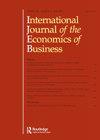银行竞争及其决定因素:来自印度银行业的证据
IF 0.9
Q3 BUSINESS
International Journal of the Economics of Business
Pub Date : 2019-04-26
DOI:10.1080/13571516.2019.1592995
引用次数: 27
摘要
本文以1996年至2016年期间印度70家商业银行为样本,对印度银行竞争程度进行了衡量。为了评估竞争程度,我们采用三种非结构性措施来估计样本中每家银行的市场力量:勒纳指数、调整后的勒纳指数和布恩指标。所有这些措施所需的边际成本的银行和年度估计是使用半参数方法获得的。本文进一步尝试对印度银行业的竞争进行全面评估,并确定各种银行特定的、宏观经济的、结构的和可竞争性指标,这些指标应该解释竞争程度随时间的水平和变化。实证研究结果表明,与私营和外国部门银行相比,印度公共部门银行的银行竞争程度相对较高。然而,总体结果支持印度银行体系总体上具有竞争力。与结构-行为-绩效范式不同,该范式主张集中化的银行体系会损害竞争力,我们的研究结果表明,集中化措施几乎不会对银行竞争产生任何影响。相反,可竞争性措施在决定银行竞争方面发挥了重要作用。本文章由计算机程序翻译,如有差异,请以英文原文为准。
Bank Competition and its Determinants: Evidence from Indian Banking
Abstract This paper measures the degree of bank competition in India using a sample of 70 commercial banks over the period 1996–2016. To assess the degree of competition, we estimate the market power of each bank in our sample employing three nonstructural measures: the Lerner index, the adjusted Lerner index, and the Boone indicator. Bank-wise and year-wise estimates of the marginal cost required in all these measures are obtained using the semi-parametric method. The paper further attempts to undertake a comprehensive assessment of competition in Indian banking and identifies various bank-specific, macroeconomic, structural, and contestability indicators, which are supposed to explain level and variation of the degree of competition over time. Empirical findings reveal that public-sector banks in India exercise a relatively higher degree of bank competition compared to private and foreign-sector banks. However, aggregate results support that the Indian banking system is competitive in general. Unlike the structure-conduct-performance paradigm, which advocates that a concentrated banking system impairs competitiveness, our findings reveal that concentration measures hardly exert any effect on bank competition. Rather, contestability measures play a significant role in the determination of bank competition.
求助全文
通过发布文献求助,成功后即可免费获取论文全文。
去求助
来源期刊
CiteScore
2.60
自引率
8.30%
发文量
9
期刊介绍:
International Journal of the Economics of Business presents original, peer reviewed research in economics that is clearly applicable to business or related public policy problems or issues. The term "business" is used in its widest sense to encompass both public and private sector—governmental, private non-profit and cooperative organizations, as well as profit-seeking enterprises. International Journal of the Economics of Business carries papers relating to three main spheres: The organization—to analyse and aid decision making and the internal organization of the business; The industry—to analyse how businesses interact and evolve within and across industries.

 求助内容:
求助内容: 应助结果提醒方式:
应助结果提醒方式:


